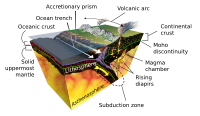
Photo from wikipedia
Author(s): Ramirez-Herrera, MT; Gaidzik, K; Forman, S; Kostoglodov, V; Burgmann, R; Johnson, CW | Abstract: © 2018 The Authors. Earthquake-cycle deformation, which includes earthquake ruptures, interseismic strain, and transient slow… Click to show full abstract
Author(s): Ramirez-Herrera, MT; Gaidzik, K; Forman, S; Kostoglodov, V; Burgmann, R; Johnson, CW | Abstract: © 2018 The Authors. Earthquake-cycle deformation, which includes earthquake ruptures, interseismic strain, and transient slow slip events, spans spatial scales ranging from fractions of a meter to thousands of kilometers. Similarly, temporal scales range from seconds during an earthquake rupture to thousands of years of strain accumulation between earthquakes. We discuss results regarding the vertical crustal deformation associated with both slow and rapid crustal deformation across a transect of the central Mexican subduction forearc in the Guerrero seismic gap, where the Cocos plate underthrusts the North America plate. This sector of the subduction zone is characterized by a flat-slab geometry with zones of sharp bending-unbending of the slab, irregularly distributed seismicity, and exceptionally large slow slip events. We used the river network, topography, geomorphic features, and morphometry on a transect across the forearc to assess Quaternary crustal deformation. The Papagayo drainage network shows that the forearc has been uplifted since the late Cenozoic (~25 Ma), and that rates of uplift increased since the beginning of the Holocene. Uplift is not homogeneous but shows a trend of increase away from the coast. This vertical deformation is strongly influenced by subduction processes. Thus, the Papagayo River network is strongly controlled by Holocene earthquake cycle processes. This is particularly true for the southern section of the drainage basin, where E-W-striking left-lateral strike-slip faults with a vertical component offset the course of the main river. These faults are accommodating part of the oblique plate convergence at the Mexican subduction zone. We measured the height of a series of terraces and dated quartz extracts by optically stimulated luminescence, and we calculated long-term rates of uplift ranging from 0.5 to 4.9 mm/yr. We discuss associations of forearc topography, faults, and long-term crustal deformation with the Cocos slab geometry, distribution of slow slip events, and earthquake-cycle deformation.
Journal Title: Geosphere
Year Published: 2018
Link to full text (if available)
Share on Social Media: Sign Up to like & get
recommendations!